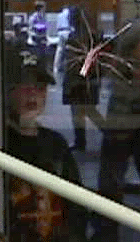Get ready to shred!

Get ready to shred!

Introduction
Plastic wrapping material used at Asian markets can be made into a "hydra" with many fine, hairlike tentacles. This hydra can be charged by rubbing it with wool and then made to fly by repelling it with a charged PVC rod.
Material
Assembly
Cut a 10 cm long piece of wrapping twine. (A piece about as long as your fist is wide.)
Use the pin to shred one end of the plastic, about 8 cm long, into many fine hairs. This will leave a piece of plastic about 2 cm long unshredded.
Exciting news, you can also cut a piece of plastic shopping bag about 1 inch wide and 4 inches long, cut one end of it into fibers with scissors and fly it in place of the hydra!
To Do and Notice
Hold the non-hairy end of the plastic and pull it through the wool several times. Notice that the hairs spread apart and are attracted to your hand.
Rub the PVC pipe with the wool until you hear it crackle.
Throw the plastic into the air and hold the rod under it.
Notice that the plastic "hydra" is repelled by the rod and can be made to float in the air by holding the rod underneath it.
What's Going On?
When you rub the plastic it becomes negatively charged. That's why the hairs repel each other. It is also why the hairs attract you, since charged things attract uncharged things.
When you rub the PVC with the wool it too becomes negatively charged. The rod will then repel the plastic hydra since like charges repel.
You can tell the charge on the plastic by using a tape electroscope, see the Tape Electroscope, short activity.
Etc.
You can also use a large piece of Styrofoam, over 30 cm square (1 foot) to fly the tinsel and the hydra.
Acknowledgments
A group of Japanese Science Teachers named Galileo Circle taught the Teacher Institute this activity.
|
Scientific Explorations with Paul Doherty |
|
25 May 2000 |